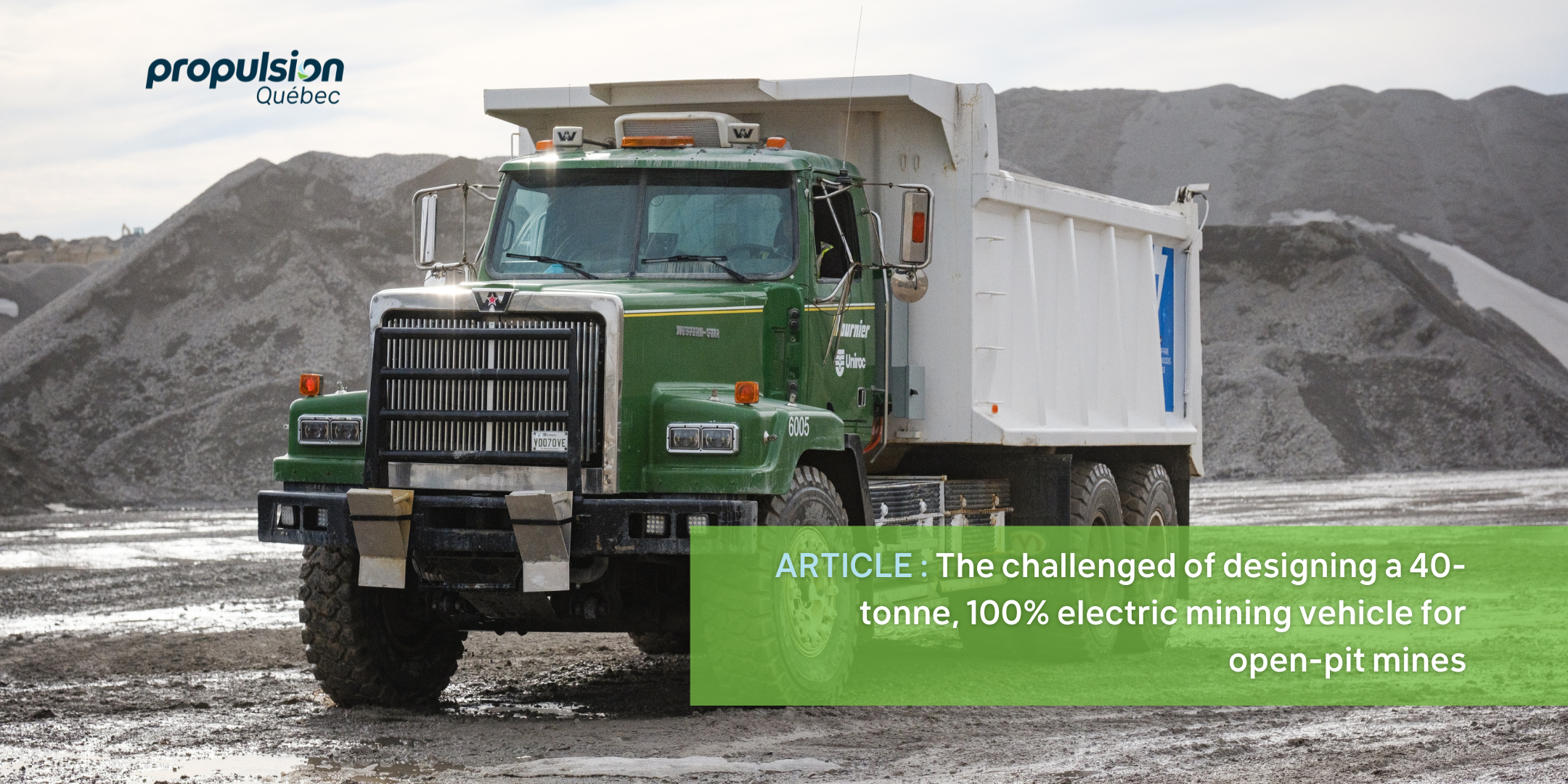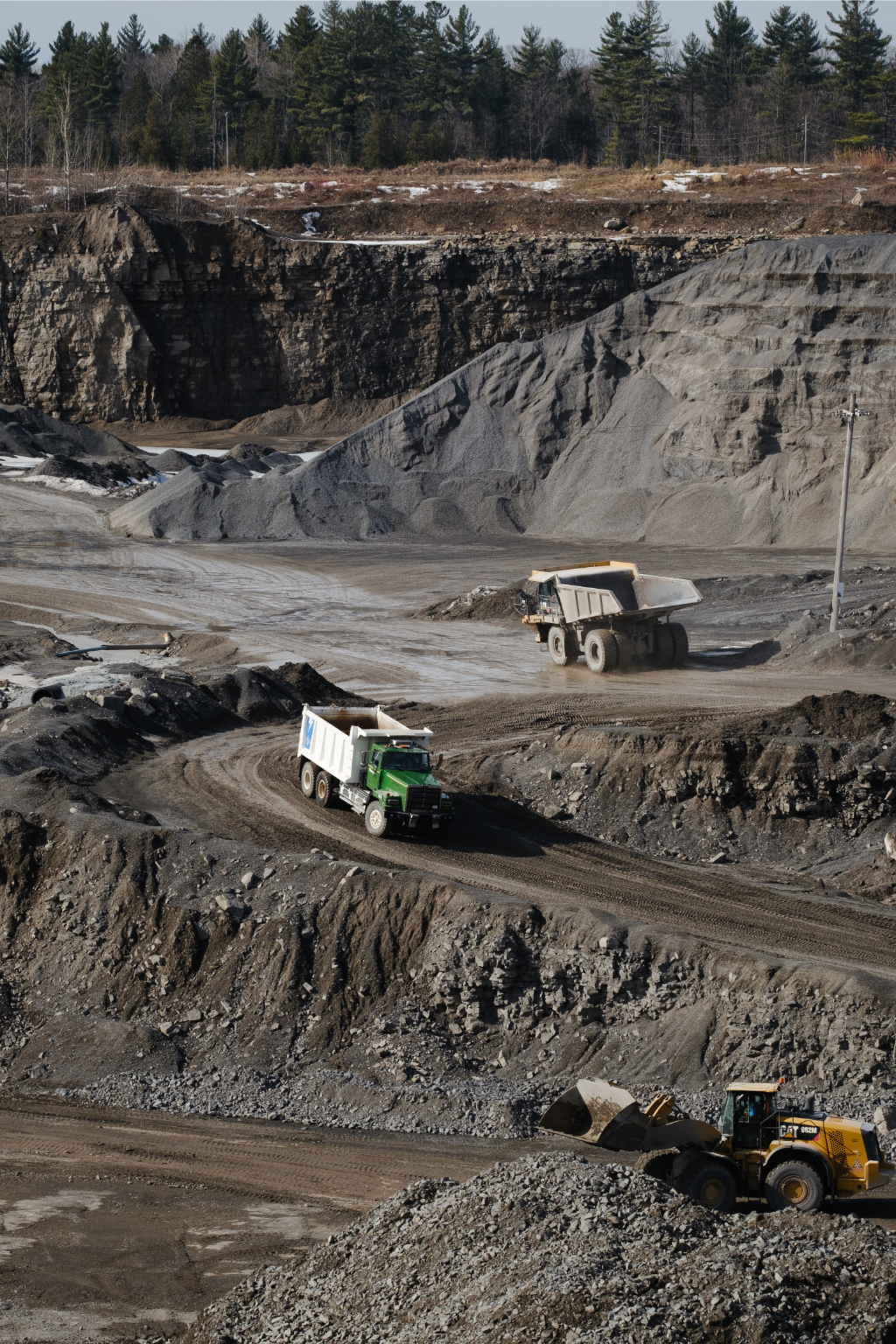The challenges of designing a 40-tonne, 100% electric mining vehicle for open-pit mines

The mining industry is facing growing environmental and economic challenges and it has become necessary to transition to more sustainable solutions. In this context, the electrification of mining vehicles appears to be a promising solution. To evaluate whether this technology is ready for large-scale implementation, we met with three partners closely involved in developing and conducting on-site testing with the first 40-tonne, 100% electric mining vehicle for open-pit mines: Eddy Zuppel, Program Leader, Clean and Energy Efficient Transportation, Guillaume Imbleau-Chagnon, Senior Project Manager, National Research Council Canada (NRC), Désirée Tremblay, Manager, Innovation and Finance Strategy with Dana TM4 and Jérémi Fournier, President of L. Fournier & Fils.
Partnerships and implications
The partners involved in the development of a 100% electric Quebec mining vehicle were all eager to be involved with the project from the outset, for a variety of reasons. NRC’s Eddy Zuppel explained their contribution: “Before starting the project, it was important to model and simulate the vehicle’s route in order to understand its energy needs and design the optimum battery pack. We also tested battery modules to ensure their performance and safety, and conducted a life-cycle analysis to evaluate the potential reduction of greenhouse gas emissions (GHG).”
Jérémi Fournier shared the vision of his company, L. Fournier & Fils: “We are one of the biggest mining companies in eastern Canada. As a partner, we provided a diesel truck bed for the electric conversion. We also shared past operational data to compare performance data. Our objective is to reduce the carbon footprint of our operations, while increasing efficiency.”
Désirée Tremblay explained that Dana TM4, which specializes in manufacturing electric drive systems for a variety of vehicles, including off-road vehicles, provided the project with a high-power electric motor. “We worked closely with another project partner, the Institut du Véhicule Innovant (IVI), to integrate the motor into the truck’s existing transmission, making sure that it can withstand the higher vibrations characteristic of mining roads.”
Interesting perspectives despite challenges
NRC’s Guillaume Imbleau-Chagnon specified that models and simulations allowed them to establish the correct dimensions for the battery pack. The exact data will be available this summer, which will assist in the development of new electric trucks or help mining operations to meet their energy needs. Across the entire electric mining vehicle development process, the partners said they encountered several challenges when designing and manufacturing the vehicle. NRC’s Eddy Zuppel highlighted the difficulty in finding a supplier for the prototype’s battery cells, which had to be adapted to off-road vehicles, while his colleague, Guillaume Imbleau-Chagnon, mentioned the limitations of the testing sites. “We were not able to test the high-power charger, which limited our vehicle charging data.” In fact, the charger will be tested at another mine site at a later date. Désirée Tremblay of Dana TM4 emphasized the importance of a robust bearing system. “We used ceramic and iron bearings, which can resist partial electric discharge.” The on-site testing is complete, and the conclusions will soon be shared.

Perspectives and innovations
Electric mining vehicles show a promising perspective. Jérémi Fournier is optimistic: “If tests confirm that the charge and range cycles meet needs, this technology represents the future of the mining industry.” Désirée Tremblay and Eddy Zuppel insist on the importance of technological adaptation. “Each mine site is unique, so the vehicles must be specifically adapted to the conditions in which they are being used,” explains Désirée. Eddy adds that operational advantages, like a reduction in vibrations and noise, can improve operator safety and satisfaction.
Nonetheless, experts are expecting continued improvements. “Battery costs continue to drop, they are becoming safer, and the efficiency of these systems is improving. These developments will make electric vehicles increasingly attractive,” states Eddy Zuppel. The transition to more sustainable solutions requires in-depth planning. Jérémi Fournier emphasizes the need to standardize certain aspects to lower costs and simplify logistics, such as battery packs and charging infrastructure. Guillaume Imbleau-Chagnon envisions modular platforms, allowing for the flexibility of adapting to the specific needs of each mining operation.
In conclusion, while there are still challenges to overcome, the partners are convinced that the technology for electric mining vehicles is on track to transform the industry. Current tests and future innovations will play a key role in this transition. Preliminary results show that these vehicles not only meet operational requirements, they also offer significant advantages in terms of durability and performance. The future of electrified mines seems promising, with the potential to reduce costs, improve safety and reduce GHG emissions.
About the partners
National Research Council of Canada (NRC)
The NRC partners with Canadian industry to take research impacts from the lab to the marketplace, where people can experience the benefits.
Dana TM4
Dana TM4 is a joint venture between Dana Incorporated and Hydro-Québec. Dana TM4 develops and manufactures low- and high-voltage electric motors, generators, power electronics and control systems for the automotive, commercial, off-highway, marine, rail, motorsports, and recreational vehicle markets.
Dana TM4 contributes to the highest possible energy conversion efficiencies through its expertise in permanent magnet and induction motors, power electronics, thermal management, coil winding, outer-rotor topology, and motor and inverter control algorithms.
L. Fournier & Fils
As a major mining contractor in Eastern Canada, Fournier offers an integrated range of high quality products and services to efficiently meet the evolving needs of its customers. Its activities focus on surface mining, particularly in the areas of mass excavation, formwork and concreting, crushing, and transportation.
This project is an initiative of the Institut du véhicule innovant, carried out with Propulsion Québec, involving Adria Power Systems, Dana TM4, Fournier & Fils and Nouveau Monde Graphite as industrial partners, and the National Research Council Canada (NRC) and CANMETMines as research partners. The project is being carried out with financial support from the Natural Resources Sector Innovation and Clean Growth Program, the Innov-R program and the Mining Research and Innovation Support Program (PARIDM). The project also receives financial support from the Fonds d’initiatives du Plan Nord and the Industrial Research Assistance Program (IRAP).
We would also like to thank Uniroc for hosting our field trials.
Photo credits: Sylvie Trépanier.





